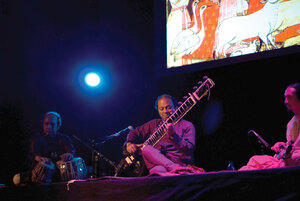Sitar master hypnotizes with Eastern flavor
On a chilly Sunday evening, an audience filled Bovard Auditorium to the balcony, waiting in deliberate anticipation for a performance noted by The New York Times as being “profound and electrifying” — quite the compliment. But would the performance live up to the already high expectations?
The performer was critically acclaimed sitar virtuoso Nishat Khan, accompanied by an equally proficient tabla player, Abhijit Banerjee. Khan learned his way around the plucked string instrument as a disciple of his father, Ustad Imrat Khan, becoming a confident player at the tender age of seven and going on to be one of the most skilled and innovative sitarists ever known.

Melodic rifts · Audiences at Bovard got a taste of traditional Hindustani music Sunday with acclaimed sitarist Nishat Khan’s performance. - Vicki Yang | Daily Trojan
But this likely did not matter to much of the crowd that night. After all, how many people know about Hindustani music or even about the sitar itself? Indeed, the music would have to speak for itself.
The concert began with Khan sitting center stage on an elevated platform, flanked on his right by tablaist Banerjee and on his left by a man quietly strumming the strings of his own sitar. Awash in orange light, the master sitarist plucked a chord, then the same chord again, letting the notes drone through the hushed air of the auditorium. Then, hypnotically again and again. Then, a voice: Khan’s voice reverberated through the air, introducing his partners onstage and offering an explanation of Hindi music characteristics, including the importance of the raga, or melodic mode.
“I wanted to bring this music to you,” Khan said.
The chord, again — except it started to shift, evolving into a melody plucked gently and softly. The lulling continued, seeping the tune with its resonating calm, but the melody grew larger, singing out with wistful vibrato applied with skilled assertion. The tabla soon joined in, first with a couple subtle beats and then with greater assertion, the characteristic scooped pitches forming not only a rhythm but a harmony to the sitar.
For the next two and a half hours, Khan and Banerjee performed with the effortless precision of true masters, captivating the audience with an intensely emotional genre of music. It was fascinating in its execution — both sleepily repetitive and beautiful, yet at times explosive beyond words as Khan riotously fired out licks that would be the envy of any musician. The concert was notable for both its vast differences from, yet pertinent similarities to, Western music. At certain moments Khan was even reminiscent of Jimi Hendrix or Eric Clapton, throwing his head back rapturously, fingers sprinting across the frets with furious energy.
Much of the music was based upon a cyclical motif, jazz-like in its execution and complexity, and ebbing and flowing at the whim of the performers. Sometimes, the melody even dissolved into surprising abstraction. Other times, the songs slowed as the notes became barely audible, practically whispered by the sitar. Whatever was being played, the crowd hung onto each note at every point in the performance, breaking the quiet only with unrestrained applause when an especially climactic portion of the piece was completed.
Undeniably, Khan’s performance was breathtaking.
The music itself was very much foreign from what you might hear at a mainstream concert. It was a testament to the dynamic performance that people sat so enamored; after all, most Americans are not exactly used to nearly hour-long compositions. But the vast majority of the crowd stayed for the whole show, which was a good thing indeed: Khan and Banerjee truly soared to new musical heights after the intermission, pushing the tempos with machine gun tabla strikes and yelping strings. Khan brought out the vocal chops — a very fine baritone — and the sitar became not just an instrument but the manifestation of emotion itself, dictating stories through the impassioned playing onstage. The show ended with a minute-long standing ovation.
Profound, electric and illuminating. These are only three of the many words that could describe what happened inside Bovard Sunday. More than anything, though, the performance truly expressed an intense fusion of the traditional and the contemporary, Eastern and Western, beauty and chaos. And if the reaction was any indication, the audience was not only impressed but touched by the music presented to them.
So did the performance live up to its hype?
Well, you should have been there.
